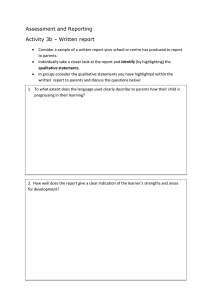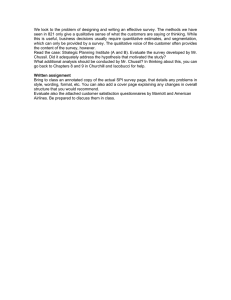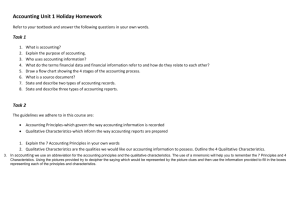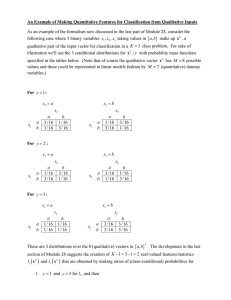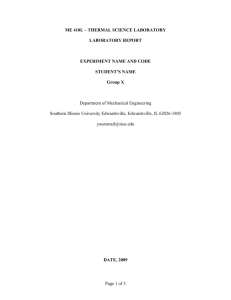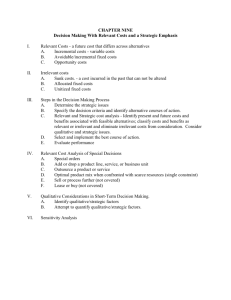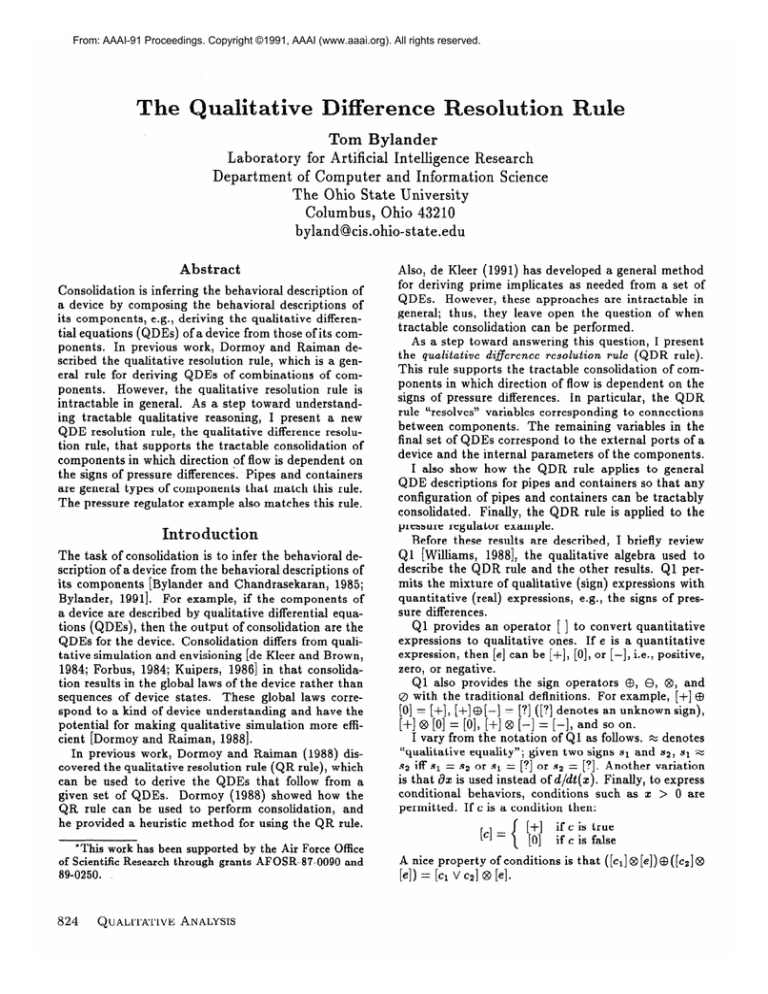
From: AAAI-91 Proceedings. Copyright ©1991, AAAI (www.aaai.org). All rights reserved.
e
ualitative
Difference
e
Tom Bylander
Laboratory for Artificial Intelligence Research
Department of Computer and Information Science
The Ohio State University
Columbus, Ohio 43210
byland@cis.ohio-state.edu
Abstract
Consolidation
is inferring the behavioral description of
a device by composing the behavioral descriptions
of
its components,
e.g., deriving the qualitative differential equations (QDEs) of a device from those of its components.
In previous work, Dormoy and Raiman described the qualitative resolution rule, which is a general rule for deriving QDEs of combinations
of components.
However, the qualitative
resolution rule is
intractable
in general.
As a step toward understanding tractable
qualitative
reasoning,
I present a new
QDE resolution rule, the qualitative difference resolution rule, that supports the tractable consolidation
of
components in which direction of flow is dependent on
the signs of pressure differences.
Pipes and containers
are general types of components
that match this rule.
The pressure regulator example also matches this rule.
Introduction
The task of consolidation is to infer the behavioral description of a device from the behavioral descriptions of
its components
[Bylander and Chandrasekaran,
1985;
Bylander,
19911. F or example, if the components
of
a device are described by qualitative differential equations (QDEs),
then the output of consolidation
are the
QDEs for the device. Consolidation
differs from qualitative simulation and envisioning [de Kleer and Brown,
1984; Forbus, 1984; Kuipers, 19861 in that consolidation results in the global laws of the device rather than
sequences of device states.
These global laws correspond to a kind of device understanding
and have the
potential for making qualitative simulation more efficient [Dormoy and Raiman, 19881.
In previous work, Dormoy and Raiman (1988) discovered the qualitative resolution rule (QR rule), which
can be used to derive the QDEs that follow from a
given set of QDEs.
Dormoy (1988) showed how the
QR rule can be used to perform consolidation,
and
he provided a heuristic method for using the QR rule.
*This work has been supported
by the Air Force
of Scientific Research through grants AFOSR-87-0090
89-0250.
824
QUALITATIVE ANALYSIS
Office
and
Also, de Kleer (1991) has developed a general method
for deriving prime implicates as needed from a set of
QDEs.
However, these approaches are intractable
in
general; thus, they leave open the question of when
tractable consolidation
can be performed.
As a step toward answering this question, I present
the qualitative diflerence resolution rule (QDR rule).
This rule supports the tractable consolidation
of components in which direction of flow is dependent on the
signs of pressure differences.
In particular,
the QDR
rule “resolves” variables corresponding
to connections
between components.
The remaining variables in the
final set of QDEs correspond to the external ports of a
device and the internal parameters of the components.
I also show how the QDR rule applies to general
QDE descriptions for pipes and containers so that any
configuration
of pipes and containers can be tractably
consolidated.
Finally, the QDR rule is applied to the
pressure regulator example.
Before these results are described,
I briefly review
Ql [Williams,
19881, the qualitative
algebra used to
describe the QDR rule and the other results. Ql permits the mixture of qualitative (sign) expressions with
quantitative
(real) expressions,
e.g., the signs of pressure differences.
Ql provides an operator [ ] to convert quantitative
expressions to qualitative
ones. If e is a quantitative
expression, then [e] can be [+I, [0], or [-I, i.e., positive,
zero, or negative.
Q 1 also provides the sign operators
$, 8, 8, and
0 with the traditional
definitions.
For example, [+] @
[0] = [+], [+I@[--] = [?] ([?] denotes an unknown sign),
[+] @ [0] = [0], [+] 8 [-] = [-1, and so on.
I vary from the notation of Ql as follows. M denotes
“qualitative equality”; given two signs sr and sz, sr z
s2 iff s1 = s2 or s1 = [?] or s2 = [?]. Another variation
is that dx is used instead of d/&(s). Finally, to express
conditional
behaviors,
conditions
such as x > 0 are
permitted.
If c is a condition then:
C
[I
A nice property
kl) = [cl V~218
=
[+]
(r1 0
of conditions
14.
if c is true
if c is false
is that ([cl] @[e]) $ ([cz] @
Unfortunately,
neither QDE follows from QDEs l-8.
For example, assigning [-] to &I, Q2, and P4 and [+]
to the other variables satisfies QDEs 1-8, but violates
QDE 9 and 10.
The problem is the inadequacy of using signs of pressures. Consider using the signs of their differences to
model Figure 1, as in QDEs 11-18:
Q2 -
Ql
[QI] = Pl 2
z
[Q21 z
P21@ [PI
P2 - Pll CB[P2
P3 - Pll 83 [P3
[Q21@ [Q31
P2 - p3la [Pz
[Q3]
P3 - P21@ [P3 - P4]
i-Q21
Figure 1: Two Three-Ended
Pipes Connected
[Qll = Pl.10 P21 0 [P3]
I-Q21 = P21 e Pll0 [P3]
2
P3le
[Qll
z
[Q21@ [Q31
iQ23
x
P218 P3leP*]
IQ31
=
P3le
P41e
L-Q41
[Q41
=
*
[QI]
i-Q41
To understand
the QDR rule, it is important
to understand the need for using pressure differences (e.g.,
[PI - pZ]) ms
* t ea d o f sr‘g n subtraction
of pressures (e.g.,
[PII 0 [Pz]). Th is also applies to pressure derivatives
as well (e.g., [a& - a&] instead of [aPi] 8 [a&]).
Using pressure differences is not a new idea; however, I
show that this modeling technique has special properties that can be exploited.
The reason for using signs of pressure differences is
that using the signs of pressures makes it difficult to
infer direction of flow. With [Q] zz [PI] 6 [Pz], [Q]
cannot be determined
if both [PI] and [.&I have the
same sign. However, [&] = [& i Pz] does not have
this defect.
To show where this difference matters, consider the
situation in Figure 1 in which two three-ended
pipes
have two connections
bet ween them .. In this situation,
it is desirable to infer that the two connected
pipes
behave like a single two-ended pipe. QDEs l-8 model
the relationships
among the flows and pressures based
on their signs.
I-Q31
I-Q31
Together
ifferences
Pressure
PI18
[Pz]
P210 [P4]
[~210 [P3]
IQ21 @ [Q31
QDEs l-4 model pipe 1, QDEs
each Pi is a pressure, and Qi,
points indicated in Figure 1.
states that if PI is positive, and
then Qi is p0sitive.r
One would expect that QDEs
the behavior of the device:
(1)
(2)
(3)
(4
(5)
(6)
(7)
(8)
5-8 model pipe 2, and
a rate of flow, at the
For example,
QDE 1
P2 and P3 are negative,
IQ11= PI1 0
[&II z IQ41
2
=
;=: P4
[&al =:
-
(11)
02)
(13)
(14
(15)
(16)
(17)
(18)
- P3]
-
P3]
-
P2]
-
P4]
p21 e3 [P4 - P3]
[Q21@ [Q33
For example, QDE 11 states that if PI is greater than
P2 and P3, then Qi is positive.
Now QDEs 19 and 20, the description of the device:
[QI] 2 Pl [Qll =
(19)
p41
[Q4]
(20)
can be demonstrated
using the qualitative
rule (QR rule)2 and the following theorem:
Theorem
resolution
1 (Qualitative
Compatibility
Rule)
are real- valued variables, then
-VX1,52,---15n
[Xl- %I 25@;z;[xi - Xi+1].
The QDE in the theorem is satisfied no matter how
the variables are ordered.
This theorem is so named
because, in the case of pressure variables, it leads to
constraints like QDE 21, which enforce the compatibility condition of system dynamics [Shearer et al., 19711:
[Pi - Ph] e
[Pi - Pj] @ [Pj - pk]
(21)
An advantage of QDE 21 over previous qualitative formulations of the compatibility
condition [de Kleer and
Brown, 1984; Williams,
19841 is that QDE 21 follows
from the Ql algebra; thus asserting additional QDEs
is not logically necessary.
Due to space limitations, I do not present the tedious
derivation of QDEs 19 and 20 from QDEs 11-18 using
the QR rule and QDE 21. Fortunately,
there is another resolution rule considerably
shortens the length
of the derivation,
and, more importantly,
generalizes
the derivation
and leads to a tractable
application.
Before the qualitative difference resolution rule (QDR
rule) is described, some useful definitions are provided.
9 and 10 would model
P41
‘If negative
pressure seems too bizarre,
consider
same QDEs using flow and pressure derivatives.
21f 2 is a rea l-valued variable, and if el and e2 are qualitative expressions,
then the QR rule can be stated as:
(9)
[x] zz el and [-xl
(10)
the
For example,
p2
- P3] CDp2
QDE
z e2 imply [0] z el CBe2
12 and QDE 15 imply [0] z [P2 - PI] @
- Pa]
BYLANDER
825
Conditional
Difference
Systems
Let Y, denote n variables yr, ~2,. . . , ym, and let X,,
denote n2 variables zi,i, zi,2, . . . , zI,~, . . . , z,,~, 2,,2,
. . . . zrrrr. I shall say that the variables Y, are dependent on the diflerences X,,
if:
l<i<?Z
[Yil X @~=t[Gjlr
[WC] 25 [Xij]Cl3[Xjk],
Xii = 0,
1 L i, j, k 5 n
l<i<n
The idea is that each yi is a “flow” variable and each xii
is a “pressure difference” variable. [~ik] z [xii] $ [xjk]
and xii = 0 are “compatibility”
constraints.
For example, QDEs 11-13 satisfy this definition in the following
way:
&I
YI =
x1 = Pl
~2 = -Q2
~3 = -Q3
32
=
P2
33
=
P3
=
Xij
Xi
-
Xj
The QDR
Finally,
Let C,,
denote n2 conditions
(refer to p. 2 for a
definition of conditions).
I shall say that the variables
Y, are conditionally dependent on the diperences X,,
by conditions C,,
if:
1I i I n
12 i, j,k 5 n
lLi<n
lli,j<n
[Yil * @j”=,( [Cijl @J[Xijl),
ixik] FZ [Xij] @ [Xjk],
Xii = 0,
[Gj] FZ [Cji],
~2
~3
Y4
Y5
Ys
x1=P1
= -Q2
= -Q3
-;2
~2
=
P2
23
=
P3
FTTFFF
TFTFFF
x4=p2
= -fj,
F’s;;;;
c&3=
FFFTFT
FFFTTF
:; 12
Xij
=
Xi
-
Xj
=
=
([Cl,31
@
h51
@ [51,51)
[PI
h31)
-
[x1,21)@
a3 h41
@ 1x1,41)@
@ ([cl,61 @ h31)
(IFI
8
PII)
(PI
@ [PL - P31)
([Cl,21 8
@
([T]
8
[PI
-
P23)@
@
([F-j
8
[PI
-
P4])@
WI @Pl = (M @PI ([+I@Pl ’ (WI@Pl = ([+IQ9Pl =
826
p51) @ (PI QDPl - 831)
Pll) @ ([+I@[PI - P23)@
p31) @ (M @ [Pl - P41)@
P51) @ (PI 8 [Pl - &I)
p21) a3([+I 8 [Pl - p31)
[Pl - P21@ [PI - p31
QUALITATIVE ANALYSIS
V
((Ci,n+l
T/T/TT
V Ci,n+2)
A
(Cn+l,j
T////T
//////
////I/
////I/
//I///
i T/II/T
//////
T/T/TT
where T and F stand for true and false, respectively.
For instance, QDE 11 can be recovered from this information as follows:
z5 ([Cl,11 @ [x1,11) @
Cij
V Cn+Z,j))
Appendix A contains the proof of the QDR rule. If
the requirements
of the QDR rule are satisfied, then
the variables yn+l, yn+2, and, for all i, xn+i,i, x++l,
can be resolved/eliminated
from the
xn+2,i,
and
xi,n+2
QDEs as long as the conditions do not refer to these
variables.
For example,
the QDR rule can be applied twice to QDEs 11-13, 15-17.
In one instance,
[y2] = [-y4] and x2,4 = x4,2 = 0. In the second instance, [yap = [-ys] and x3,5 = x5,3 = 0. The successive results of the two applications
to the Ce,e matrix
in the previous column are as follows:
I
[Qll = [Yll
Rule
the QDR rule can be specified.
Theorem 2 (Qualitative Difference Resolution Rule)
If Yn+2
is conditionalby dependent
on Xn+2++2
by
c n+2,n+21
if [Y,+I] = [-Y~+zI,
and if xn+1++2 =
dependent on
x,+z++I
= 0, then Yn is conditionally
X,,
by CL,, where CL, is determined from Cn+2,++2
by:
C{j
a conditional difierence
I shall call Y,, X,,,
and C,,
system.
This extends the idea of dependence on differences so
that a flow can be conditionally
dependent on pressure
differences. For example, QDEs 11-13, 15-17 form the
following conditional difference system:
Yl =Q1
Two conditional
difference systems can be merged
into a single conditional difference system by adding
compatibility
constraints
and lots of F conditions.
Thus, if each component
in a device is described as
a conditional difference system, then the combination
of the components
with additional compatibility
constraints is also a conditional difference system. Often,
the compatibility
constraints
are theorems of qualitative algebra, such as QDE 21.
Note that if two components
are connected,
then
their flows (and flow derivatives)
at the connection
have opposite signs (assuming some reasonable
convention, e.g., flow inward is positive) and their pressures (and pressure derivatives) at the connection
are
equal.
In the example conditional
difference system
above, [yz] = [-y4] and 22 = x4.
////I/
T/T/TT
T/T/TT
I
In the first application,
the second and fourth
columns and rows are resolved, which is indicated by
the /‘s. The conditions in the remaining 4 x 4 matrix
are
all
T,
e.g.,
&,5
=
~1,5~((~1,2~~1,4)~(~2,5~~4,5))
=
Fv((TvF)A(FvT))=T.
In the second application,
the third and fifth
columns and rows are resolved, leaving only [Qr] z
[PI - PI] @ [PI - P4] = [PI - Pa] and [-Q4]
==:
P4
- PII
@ EP4 - P41 =
[P4 - PII.
QDE 20, [Qll = [Q41,
follows.
In general, the size of conditions derived using the
QDR rule can grow combinatorially.
However, if all the
conditions are either T or F, then all the conditions
derived using the QDR rule will also be either T or F.
This leads to the following theorem:
Theorem 3 (QDR Tractability)
If Y, is conditionally
dependent
on X,,
by C,,,
if
each condition in Cnn is either T or F, and if there
are m two-element
disjoint sets (i, j),
1 5 i, j 5 n,
indicating
equalities of the form [yi] = [-yj]
and
= Xji = 0, then there is an O(mn2) algorithm for
2.'
eliminating all the variables that share a subscript
any of the m sets.
with
ports:
variables:
constraints:
Theorem 4 (Qualitative
Continuity
Rule)
If Y, is conditionally dependent on Xnn, then
For example, QDEs 11-13
ence system as follows:
=&I
form a conditional
Xij =
52 = P2
x3 = P3
Xi
From the qualitative
follows:
-
Model for Pipes
portl, . . . , port,
Qi, Pl, . . . , Qn, -Cat A, P
[Qil ==:[Pi - PI,
[-aA] x @y=l[f’ - Pi]
[aQi] * [aPi - aP],
[-d2A] z $;El[dP
- aPi]
l<i<n
lLi<n
PI ==:Ml
[aP] =: [aA]
Figure
3: Qualitative
Model for Containers
differ-
Qi is negative if flow is outward. P; is the pressure at POT&.
Semantics of connection are: Each port
can be connected to at most one other port. If porti is
connected to portj, then Qi = -Qj and Pi = Pj.
Figure 2 defines two sets of QDEs.
The first set
specifies n QDEs, relatin g each Qi to the pressures.
The direction of flow for any porti corresponds to the
“sum” of pressure differences (the sign summation
of
Pi minus other pressures).
The second set specifies
similar QDEs for the first derivatives.
porti;
Theorem 5 (Pipe Continuity Laws)
For a pipe with n ports,
@y=,[Qi]
z
[0]
and
@:‘I [aQil z [Ol-
Xl = PI
~2 = -Q2
y3 = -Q3
2: Qualitative
1 5 i < n
Continuity
Before describing examples of using the QDR rule, it is
interesting that QDE 20, the qualitative conservation
law for the configuration
in Figure 1, can be derived
without using QDEs 14 and 18, the qualitative conservationlaws for the components.
It turns out that QDE
14 can be derived from QDEs 11-13, and QDE 18 can
be derived from QDEs 15-17. There is a general rule
that underlies these derivations:
YI
l_<i<n
[Qi] z @;=I [pi - pj],
[aQi] z @j”,l[aPi
- aPi],
Figure
Using the QDR rule, there are O(n2) updates to be
performed for each pair of equalities.
Because each
condition is either T or F, the size of the conditions
do not increase.
m pairs of equalities imply O(mn2)
time.
ualitative
portl, . . . , port,
Qi, PI, . . .,Qn,Pn
ports:
variables:
constraints:
F
T
T
c3,3 =
Xj
continuity
[Qll @ k&21 @ Pi?31
(QC)
=:
T
F
T
rule,
Dl
The QC rule applies to the QDEs
T
T
F
QDE
22
(22)
which is equivalent to QDE 14, [Qi] 2 [Q2] $ [Qs].
Thus, a conditional
difference system of flows and
pressure differences implies a qualitative version of the
continuity
condition of system dynamics
[Shearer et
al., 19711. Similar to the qualitative compatibility
rule,
an advantage of the QC rule over previous qualitative
formulations of the continuity condition [de Kleer and
Brown, 1984; Williams, 19841 is that the QC rule follows from a conditional difference system and is not an
additional “law” that must be added to constrain the
system.
ipes
Figure 2 is a qualitative model for pipes with n ports,
n 2 1. Qi is the rate of flow into the pipe through
given in Figure
2.
Theorem
6 (Pipe
Consoliclation
Law)
If a pipe with m ports has k connections to a pipe with
n ports (k < m and k < n), then a pipe with m+n2k
ports describes their combined behavior.
Just as the QDR rule was applied twice for the two
connections
in Figure 1, it can be applied k times for
k connections
to obtain the QDEs relating flows and
pressures at the external ports and another k times to
obtain the QDEs relating flow and pressure derivatives.
Containers
Figure 3 is a qualitative model for a container with n
ports, n 2 1. In addition to the ports’ variables, A
is the amount in the container, and P is the pressure
inside the container.
The constraints
as shown in Figure 3 are: (1) The
direction of flow at any port is the sign of the difference between the port’s pressure and the container’s
pressure.
(2) Change in the container’s
amount depends on the qualitative
sum of the differences
between the container’s pressure and the ports’ pressures.
For example, the container’s
amount will increase if
BYLANDER
827
c----------q
I
5
I
If the valve is open (V > 0), then the direction of flow
Qr corresponds
to the sign of the pressure difference
PI - P2; else Qi is zero. To map QDE 23 to a conditional difference system, the condition V > 0 can be
used.
,8’s flow derivatives are modeled in part by QDE 24:
I
I
C------.mr-r'l1
I
I
b--v
;
II
p----m+
I1
cl!
L-------L
Iii
p--4
tm-----l+-e..q
211 211
rl:'
A---------l
Figure 4: Components
of The Pressure
Regulator
the container’s pressure is lower than the ports’ pressures. (3,4) The flow and pressure derivatives and the
amount’s second derivative have similar constraints.
(5,6) The container’s
pressure depends on the container’s amount.
In particular,
pressure increases or
decreases as the amount increases or decreases.
Theorem 7 (Container
Continuity
Laws)
For a container
with n ports, @y=,[Qi]
x [aA]
and
@y=l[aQi] z [a2A]
The QC rule directly applies to the containers QDEs.
The QDR rule can clearly be applied to connected
pipes and containers.
However, two connected containers cannot be described as a single container because
the consolidated QDEs will have two amount and two
pressure variables associated with the two containers.
The QDR rule eliminates the variables of the connected
ports, but does not eliminate “internal” variables. Of
course, [P] e [A] and [aP] x [aA] should be kept in
any consolidated description.
The container model does not place any restrictions
on the ranges of pressures and amounts.
To model
containers with lower limits of zero for pressures and
amounts, one can simply require A 2 0 and P > 0.
To model a container with maximum capacity A,,,
,
[dP] GZ[aA] can be replaced with [A < A,,,]
@ [aP] x
PAI.
The Pressure
Regulator
Due to space limitations,
the consolidation
of the pressure regulator cannot be described in detail. Instead,
I focus on how the concept of conditional
difference
systems applies to a model of this device.
Figure 4 shows the division of the pressure regulator
into four components.
(Y, 7, and 6 are pipes with 2,
3, and 2 ports, respectively.
p is a valve, which is
modeled as a component with three ports, one of which
is “blocked.” Although no flow can occur through ,0’s
third port, it still is a point of interaction,
in this case,
with the pipe 6. In particular,
the pressure from 6 will
be the “pressure” to close the valve’s position.
Beside the usual flow and pressure variables, p also
has a variable V indicating whether the valve is closed
(V = 0), completely open (V = V,,,),
or in between.
Flow through the valve is modeled in part by QDE 23:
[Qll *
828
[v > o] @ [PI - Pz]
QUALITATIVE ANALYSIS
*
PaI
21
(23)
([v > 01 63 [aPI - 8P2]) a3
([v > 01@WI @[PI -
(24)
p21)
Change in flow is influenced both by changing pressures
as well as by a changing valve position. QDE 24 cannot
be directly mapped to a conditional difference system
because it has two terms for the interaction
between
podI and poTt2. However, QDE 24 can be modified to
QDEs 25 and 26:
[WI
PQII = [v > 01(23
[WI 25 @‘PI
- dP21)
@
(25)
([av]
@
[PI
-
P21)
(26)
V > 0 then is the relevant condition.
Also, “compatibility”
constraints
must be specified, e.g., 21,s =
52 and [51,3] z [zi,~] @ [x2,3]. This additional inx1formation leads to a conditional
difference system for
the flow and pressure derivatives.
QDE 27 governs change in the valve’s position:
[W]
x
[V
>
OA
V
<
Km,]@[-aP3]
(27)
If the valve is not closed or completely open, then the
valve position decreases (increases)
if pressure at the
blocked port increases (decreases).
To my knowledge,
QDE 27 cannot be mapped to a conditional difference
system.
Remarks
The QDR rule can be used to perform tractable consolidation of components for which the direction of flow is
dependent on the signs of pressure differences.
In this
paper, we have shown that pipes and containers can be
modeled to fit the QDR rule. With the exception of
one QDE, consolidation
of the pressure regulator can
also be accomplished with the QDR rule. I believe that
the QDR rule explains why many examples in the qualitative reasoning literature can be efficiently processed.
To the extent that the components
in these examples
are pipe-like or container-like,
efficient reasoning can
be guaranteed.
One limitation of the QDR rule is that no variables
in the conditions are eliminated.
The simplest example
of this limitation is a one-way valve, which would have
a QDE like [Qi] x [PI > P2] @ [PI - Ps]. If a one-way
valve is connected to three-ended pipes, there is no easy
solution to eliminating
PI and P2 in the condition.
Another limitation
is that the QDR rule results in
loss of information.
For example, if there is one connection between two three-ended
pipes, the consolidated
QDEs do not enforce the constraint that flow from one
pipe to the other can only be in one direction.
In
this sense, the QDR rule produces abstractions of connected components,
and not equivalences.
The final, perhaps most important, limitation is that
the QDEs of a component must have the appropriate
form, i.e., be a conditional difference system. Whether
our approach can be extended to additional types of
components
(e.g., pumps, transformers)
and phenomena (e.g., momentum,
heights), and, if not, what additional resolution rules are needed, are the subject of
further investigation.
Proof of the QDR
The QDEs for a conditional
Rule
difference
system
include:
Because
sn+1++2
=
0
and
@
=
$
for all j between 1 and n + 2, it follows that
for all j between 1 and n + 2. With
%~+2,n+1
= 0, ~+1,,+1
= 0, and 2,+~,~+2
= 0, the
following QDEs can be derived:
E%+l,jl M [S,+z,j]
x [-yn+2],
II01R5$j”=l(Lcn+l,j
@[xn+l,j])
the QR rule can be applied,
V Cnt2,jl @
[%tl,jl)
Considerw-1,1. x1,1 = 0 and [x1,1]= [qntl] CD
bntl,ll implies[z,+I,I] = [--~EI,~+I],
so:
[cn-tl,l
v
@~~2([cntl,j
Assume
w-2,11 QD b1,*+11
x
V cnt2,jl
@ [%tl,jl)
that c,+l,l
V c,,+z,l
is true, i.e.:
E21,n-k11
x @~=2([Cntl,j V C,tZ,jl @ [Xn+l,j])
Because
[qd-l]
25 [3l,2]@
x [- ~~+r,2], the QR rule can be applied:
hrr+11 @ uc,t1,2
v c,+2,21(8 [~l,ntIl)
(hat1,2 v c,+2,21@ [q21)@3
@Ts3(Lcntl,j V cnt2,jl @ [%tl,jl)
*
Note that [z i,ntil @([Cl@ [~i+t-i]) = [21,,+1]for any
condition c. Further note that the QR rule can be similarly applied for the remaining j from 3 to n, resulting
in:
[51,ntll e
NOW
@~=2[Cntl,j
consider
[zi,n+r]
[Yll
Fz
@
[zl,j])
the QDE for yr:
[Yll
Because
VCnt2,jl
c BBi”=fi2([Cl,jl
@ [zl,jl)
= [z1,,+-2], it follows that:
hLtl
v C1,ntzl
which after a few simplifications
x
becomes:
V (( C1,n-k1
@j"=l([Cl,i
v
QLt2)A
V Cnt2,i))l @ lIzl,jl)
EYll 7z @j”=,([d.,il
@ [Xl,jl)
The other QDEs for y2 to yn can be similarly
rived. c{j = c$i follows from cij = cji. QED.
de-
Bylander, T. and Chandrasekaran,
B. 1985. Understanding behavior using consolidation.
In Proc. Ninth
Los AngeInt. Joint Conf. on Artificial Intelligence,
les. 450-454.
Bylander, T. 1991. A theory of consolidation
soning about devices. Int. J. Man-Machine
to appear.
for reaStudies.
de Kleer, J. 199 1. Compiling devices. In Proc.
National Conference
on Artijkab Intelligence,
heim, CA.
Ninth
Ana-
de Kleer, J. and Brown, J. S. 1984.
A qualitative
Artificiab Intelligence
physics based on confluences.
24~7-83.
Dormoy, J. 1988. Controlling
qualitative
resolution.
In Proc. Seventh National Conf. on Artificial Intelligence, St. Paul, MN. 319-323.
[x2,n+l]:
ht1,2
v Gkt-2,21
Q9bl,ntll
=
(hbt1,2 v c,t2,21 QD[*1,21)@
h-1,2
v c,t2,21 Q9~~2,72+11)
Since [a2,n+l]
([Cl,?d-1v Cl,,-k21~
($j”,2[Cntl,j V c,+2,jl @ [Xl,jl))
@ $j”=~([cl,jl @ Lxl,jl)
References
[Yn-l-11z @~=~([Cntl,jl @ [%tl,j])
Because [y+r]
leading to:
=
which is the same as:
[~~+l,~+2]
[z,+z,j]
h+21a @j=l([cn+z,jl
LYll
CCntl,i
[%+2,j])
[xn+l,j]
that cij = Cji, SO Cn+l,l
V %-l-2,1
=
Ct,ntl
V
Hence, xl,,+.1 is a factor only if [c,+i,i VC,+~,~]
is true, so the QDE for x i,n+i derived above under the
assumption that [cn+i,i Vc,+2,1] is true can be used to
substitute for [xi,n+i], leading to:
[Yll
EYn+ll
x $j”,+l”([Ga+l,jl
@3[%+l,j])
[yn+Zl * @i”=‘,“c[cIL+2,j]
Recall
Cl,n+2*
Dormoy, J. and Raiman, 0. 1988. Assembling a device. Artificial Intelligence
in Engineering
3(4):216226.
Forbus, K. D. 1984. Qualitative
tificial Intelligence 24:85-168.
process
theory.
Kuipers, B. J. 1986. Qualitative
Intelligence 29(3):289-338.
simulation.
Ar-
Artificial
Shearer, J. L.; Murphy, A. T.; and Richardson,
H. H.
1971.
Introduction
to System Dynamics.
AddisonWesley, Reading, MA.
Williams,
B. C. 1984. Qualitative
analysis
circuits. Artificial Intelligence 24:281-346.
of MOS
Williams, B. C. 1988. MINIMA: A symbolic approach
to qualitative
algebraic reasoning.
In Proc. Seventh
National Conf. on Artificial Intelligence,
St. Paul,
MN. 264-269.
@ bh,n+1])@
@;=I (Icl,jl @I [Sl,jl)
BYLANDER
829

